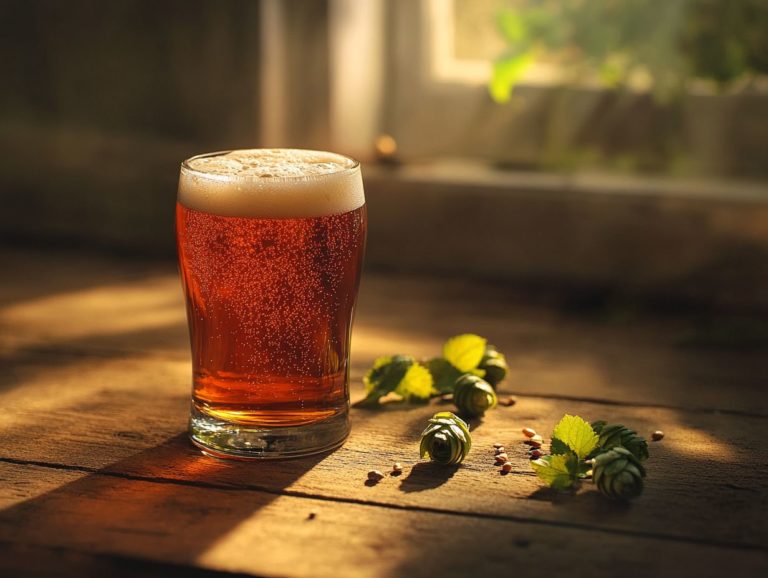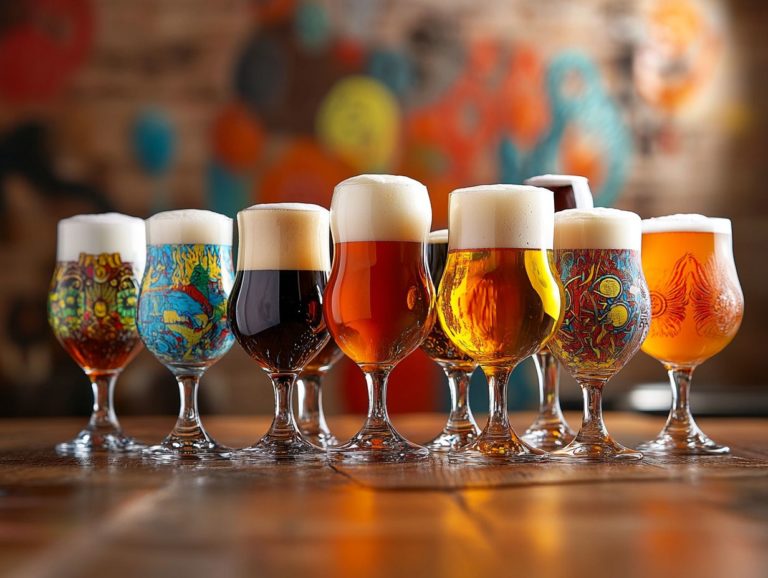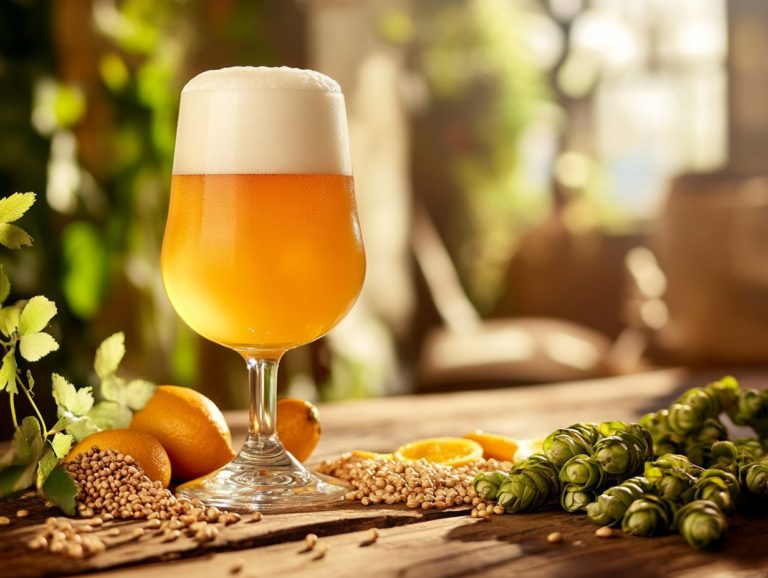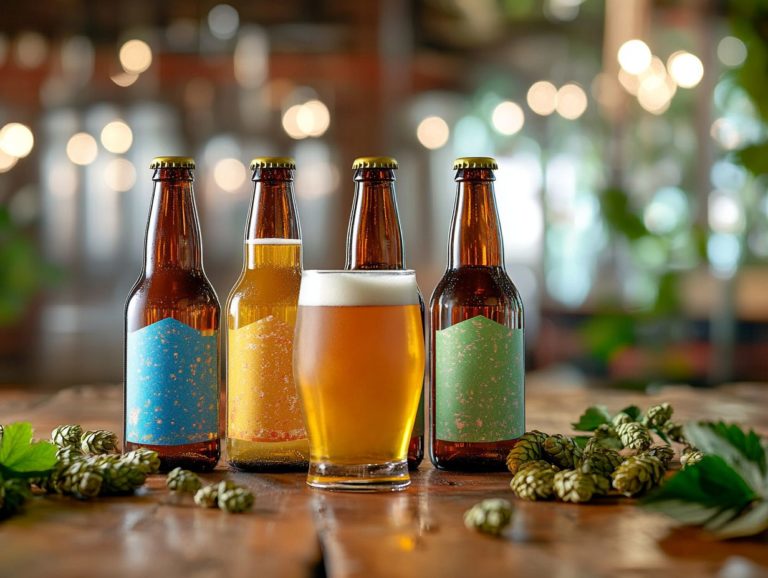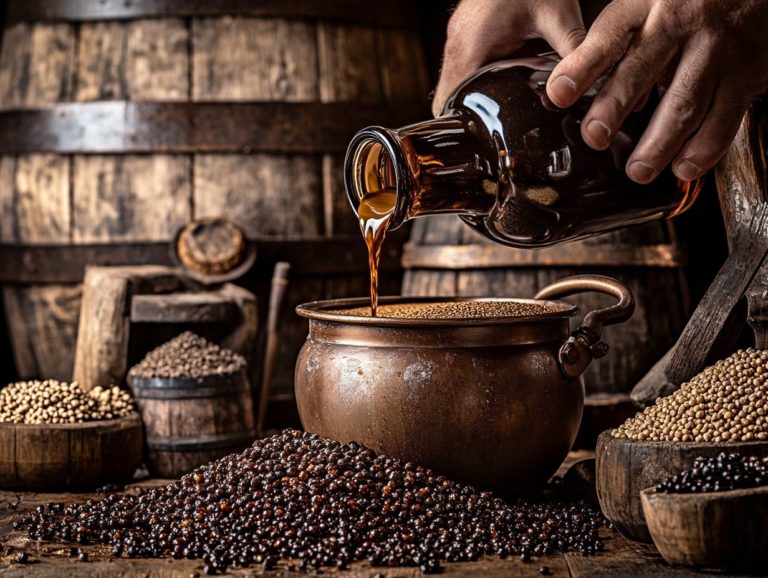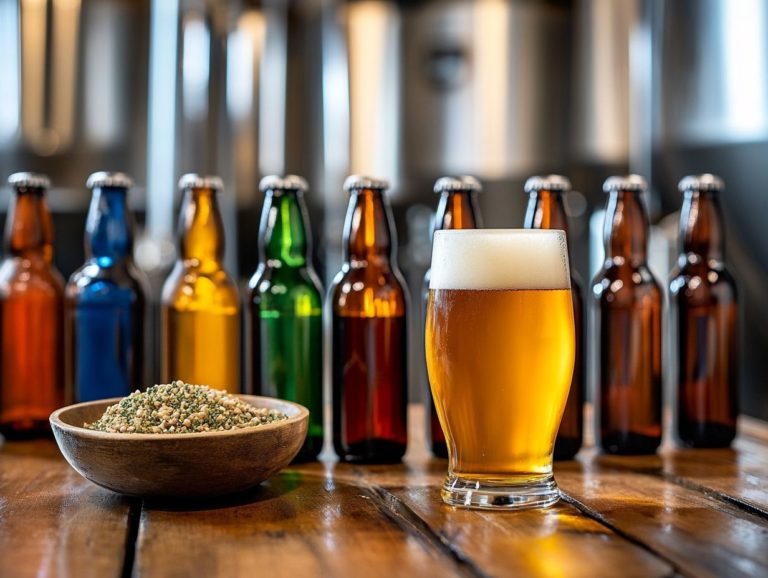Understanding the Different Lager Styles
Lager, one of the most beloved beer styles across the globe, carries with it a rich history and an impressive spectrum of flavors. From light to dark, and even complex sour ales, there s a lager for every beer enthusiast.
From the crisp and invigorating Pilsner to the robust and malty Dunkel, there s a lager that caters to your unique palate.
Join us as we explore the evolution of lager and its various styles, allowing you to appreciate their distinct characteristics.
You ll uncover expert tips on selecting the ideal lager that suits your taste, discover the best food pairings, and learn optimal practices for serving and storing your favorite brew, including types of beer like wheat beer, pale ales, and even stout.
Don t miss out on exploring the fantastic world of lagers!
Contents
- Summary of Lager Insights
- The History of Lager and Other Beers
- Exploring Lager Styles and More
- Exploring Lager Styles
- Understanding Different Lager Styles
- Choosing the Right Lager Style
- What Flavors and Aromas Should You Look for in a Lager?
- What Foods Pair Well with Different Lager Styles?
- How to Properly Serve and Store Lager?
- Frequently Asked Questions About Beers
- Exploring Different Types of Lager Styles
Summary of Lager Insights
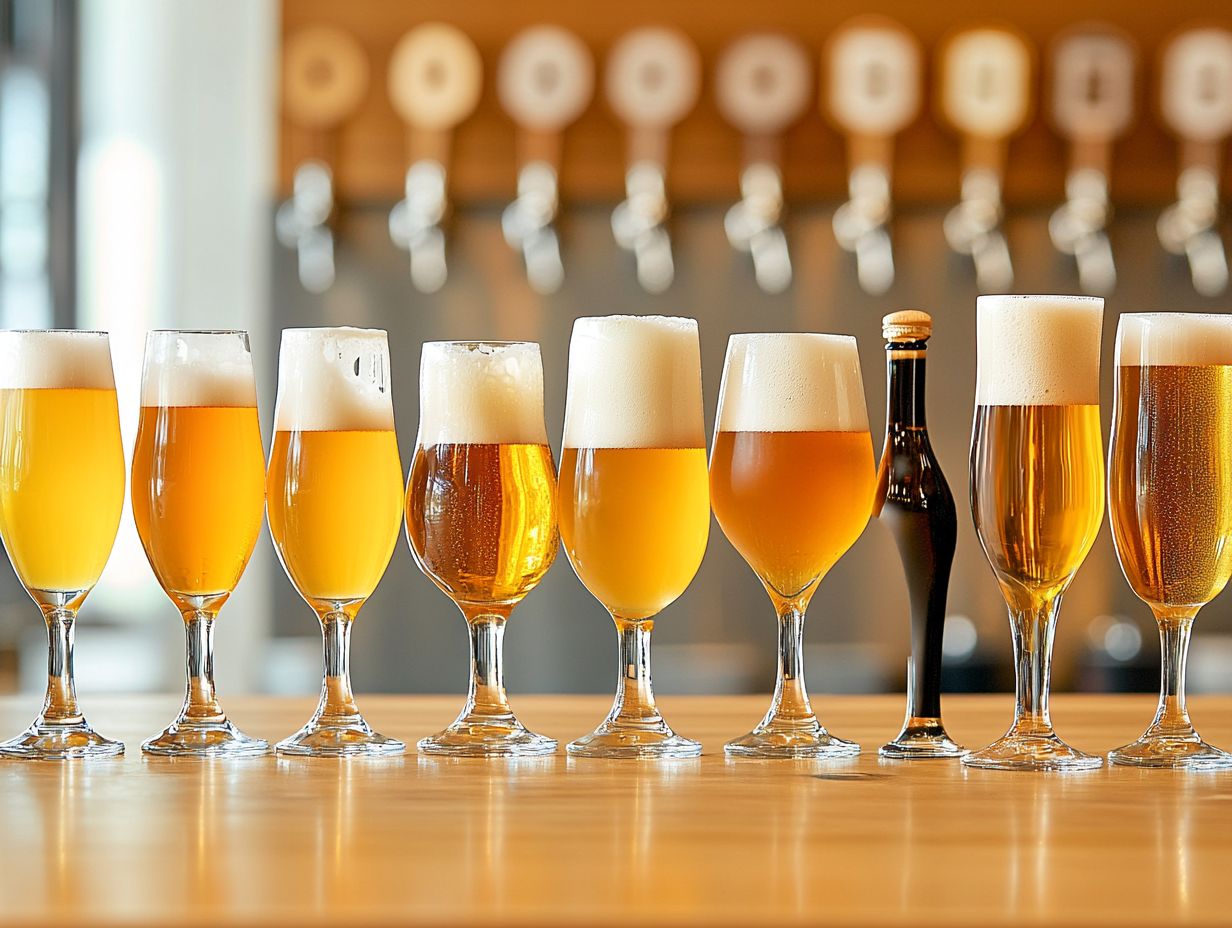
- Lager styles range from light and refreshing Pilsners to dark and rich Bocks, each with their own unique flavors and aromas. You can also explore hoppy IPAs and fruity Belgian beers for a broader palate experience.
- When choosing a lager, consider the flavors and aromas you enjoy and pair them with complementary foods for a well-rounded experience.
- To properly serve and store lager, keep it at a cool temperature and consume it within a few months for optimal taste and freshness.
The History of Lager and Other Beers
The history of lager unfolds as a captivating journey that takes you back to the early 15th century in Germany. The fermentation process, made with cool fermentation and specific types of yeast, gave rise to the clean, crisp beers you cherish. This period also saw the emergence of other beer styles like ales and stouts.
As brewing techniques advanced, lagers began to assert their dominance in the American brewing landscape. This paved the way for the craft breweries that now present a dazzling array of unique options for discerning beer enthusiasts like yourself. The influence of Belgian beer and the American craft beer revolution, led by figures like Jim Koch of Boston Beer Co., further diversified beer drinkers’ options.
This historical narrative beautifully illustrates the intricacies of lager, from its malty sweetness to its refreshing profile. It underscores the pivotal role that yeast and fermentation play in crafting the flavors you enjoy today.
Exploring Lager Styles and More
Lager styles offer an impressive array of flavors and characteristics that cater to your unique palate and preferences. From the crisp and refreshing notes of a Pilsner to the rich, malty sweetness found in a M rzen, there s a lager style that speaks to you. Don’t forget to also explore other types of beer, including hoppy IPAs and classic Belgian ales.
Each variant, such as Helles and Dunkel, showcases distinct brewing techniques and ingredients. This beautifully reflects the cultural influences of German and American brewing traditions. This remarkable diversity highlights the artistry involved in brewing and presents you with a vast selection of options to explore whether you lean towards light, dark, fruity, or hoppy profiles.
Classic lagers and modern craft beers alike offer a plethora of drinking experiences.
Exploring Lager Styles
Pilsner
Pilsner is a celebrated lager style that hails from the Czech city of Plze , known for its crisp, refreshing qualities and distinct hop flavors that come together to create a balanced, clean taste. With its bright golden hue and moderate bitterness, it’s no wonder this beer has earned a special place in the hearts of beer drinkers everywhere!
This showcases the classic characteristics of German brewing methods that have influenced countless craft beer offerings around the world. Whether you prefer light beer or dark beer, Pilsner offers a delightful experience.
The story of Pilsner unfolds in the mid-19th century, when local brewers, driven by a desire for quality beer, crafted this iconic lager. Its success can be attributed to an innovative brewing process that utilizes soft water, pale malts, and the renowned Saaz hops. The careful fermentation and cold lagering techniques contribute to its remarkably smooth character.
Over time, various adaptations have arisen, including German Pilsners, which offer a crisper finish, and American Pilsners, often embracing bolder flavors. The Pilsner has become a staple in the flavor ladder of beers, inspiring brews from local watering holes to international craft breweries.
As the years have passed, Pilsner has grown in cultural significance, becoming a symbol of celebration and camaraderie. It’s now a go-to choice in bars and breweries around the globe, making it the perfect companion for social gatherings and memorable moments.
Helles
Helles is a traditional Munich-style lager that you ll appreciate for its malt-forward profile, delivering a light and clean taste that sets it apart from its more hop-heavy relatives like Pilsner. This lager style truly celebrates the sweetness of pale malts while maintaining a harmonious balance, making it an exceptionally smooth and easy-drinking choice for any beer aficionado! It’s the perfect introduction for those new to the complexities of brewing and beer tasting.
Emerging from Germany in the late 19th century, Helles emerged as the perfect refreshing alternative to the more bitter lagers that dominated the landscape at the time. The brewing process involves a meticulous selection of high-quality malts paired with a gentle touch of hops, allowing the malt sweetness to take center stage without being overshadowed.
You can expect a flavor profile that includes delightful notes of bread and cracker-like maltiness, complemented by a mild floral aroma.
Renowned breweries like Spaten and Paulaner have become synonymous with Helles, expertly showcasing its crisp finish and lively carbonation. This style comfortably fits within the broader lager category, offering you a delightful experience that’s perfect for social gatherings or leisurely afternoons.
Vienna Lager
Vienna Lager is a unique lager style that you’ll quickly recognize by its amber hue and the rich, caramel malt flavors that offer a complex drinking experience. Originating in the 19th century, this style perfectly embodies the harmonious balance of malt sweetness and mild hop bitterness, making it a favorite for those who appreciate a deeper flavor profile in their beers.
Alongside other styles of beer like porter and stout, Vienna Lager showcases the diverse range of drink options available to beer lovers.
This lager has its origins in Austria, where brewers skillfully utilized Vienna malt to create a brew that marries elegance with a hearty character. The fermentation process typically involves yeast that ferments at the bottom of the tank at cooler temperatures, which contributes to its clean finish. The use of selective yeast and precise fermentation techniques highlights the craftsmanship behind this style.
You ll notice notes of toasty bread, subtle noble hop aromas, and a hint of sweetness that set Vienna Lager apart from other lagers like Pilsners or Helles. Beyond its delightful taste, this style also has significant cultural importance, having inspired a myriad of craft brews worldwide. It reflects the timeless heritage of brewing traditions that continue to shape modern beer.
For enthusiasts, Vienna Lager is cherished not just for its flavor but also for its historical roots and the craftsmanship that goes into its creation.
Understanding Different Lager Styles
Marzen/Oktoberfest
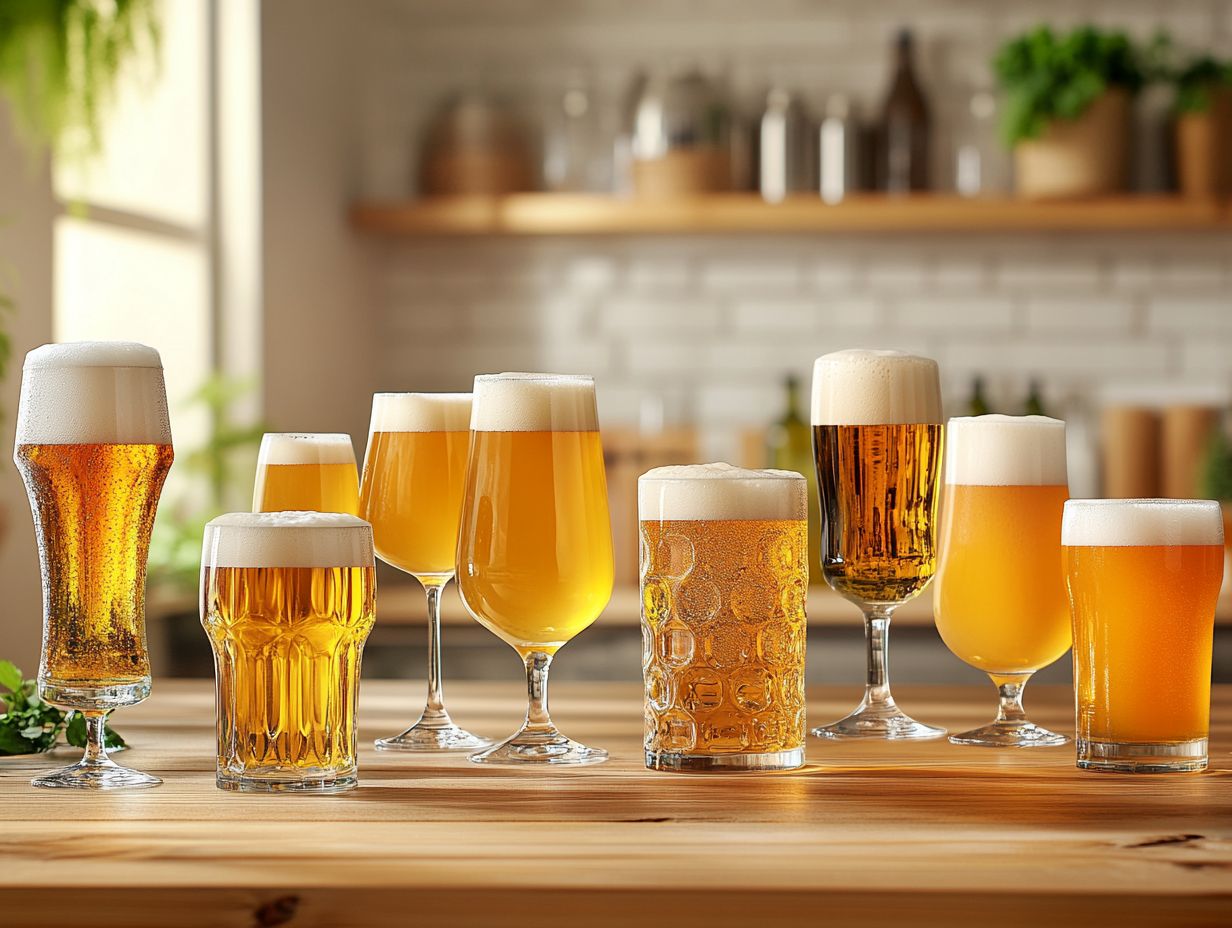
M rzen, often referred to as Oktoberfest beer, is a traditional German lager that captivates with its malty richness and deep amber hue. It is a seasonal delight during beer festivals and celebrations.
The brewing process involves a higher initial sugar content, resulting in a fuller-bodied beer that offers a smooth, slightly sweet finish. This makes it an ideal companion for hearty fall dishes.
Its influence is evident across various brewing traditions, from classic German lagers to innovative American lagers. Historically brewed in March and enjoyed throughout the warmer months, this beer holds a special place in Bavarian culture, particularly during the renowned Oktoberfest.
The brewing begins with a meticulous selection of malts, frequently featuring Munich and Vienna varieties. These lend caramel notes and a toasted character to the final brew.
When you take a sip of M rzen, you’ll discover a harmonious balance of sweetness and mild bitterness. It is enriched by flavors of toffee and nuts that elevate the tasting experience.
This beer pairs beautifully with roasted meats, pretzels, and sausages, making it the perfect partner for festive gatherings and traditional German cuisine.
Bock
Bock is a remarkable lager style that hails from Germany, distinguished by its robust malt character and higher alcohol content compared to other lagers. This style can range from light to dark.
The darker variants present rich, complex flavors often featuring delightful hints of chocolate and caramel. These flavors are perfect for those who relish a more indulgent drinking experience.
Among the different types, Doppelbock truly shines with its elevated gravity and richer malt profile. It is often described as sweet and full-bodied, making it an ideal companion during the colder months.
Then there’s Eisbock, crafted through a unique freezing process that intensifies its flavor and alcohol content, resulting in an even bolder experience.
Bock beer holds significant cultural importance in Germany, especially during festive celebrations like Oktoberfest, where it heralds the arrival of spring. Craft breweries worldwide are embracing this beloved traditional style!
Dunkel
Dunkel is a dark lager that reveals a rich malt profile. It delivers delightful flavors of caramel, toffee, and a whisper of chocolate, perfect for those who seek a beer with both depth and character.
This traditional Bavarian style beautifully emphasizes malt sweetness while ensuring a clean finish. It showcases the true artistry of German brewing.
The complexities of this style are a testament to the diverse range of drinking experiences available in the world of beer. Its roots can be traced back to the early monasteries of Bavaria, where monks meticulously crafted these brews as both nourishment and refreshment.
The use of Munich malts in the brewing process imparts Dunkel’s distinctive deep color and robust flavor, setting it apart from other dark ales like stouts and porters, which often lean on roasted barleys.
Dunkel is a beloved style of German beer that showcases the intricate brewing techniques developed over centuries. The intricate lagering process enhances its smoothness, allowing you to fully appreciate the nuanced interplay between the malt’s sweetness and a very subtle bitterness.
As a result, this dark lager appeals not just to craft beer aficionados but also to casual drinkers who appreciate a balanced and approachable option. Its alcohol content remains moderate, making it a versatile drink for various occasions.
Dive into the rich world of lagers and discover your new favorite brew this season!
Schwarzbier
Schwarzbier, or black beer, is a remarkable German lager that captivates with its deep black color and smooth, roasted malt flavor profile, distinguishing it from other lagers. You ll notice its well-balanced taste, which includes delightful hints of coffee and chocolate, resulting in a rich and easy-to-drink experience.
What truly sets Schwarzbier apart is not only its striking appearance and flavor but also the careful brewing process behind it. The use of dark malts, expertly roasted to perfection, enhances the beer’s aromatic complexity and imparts a pleasing, slightly sweet finish that lingers on the palate. This dark lager is favored by those who enjoy various brewing styles.
Historically, Schwarzbier has roots steeped in the rich brewing traditions of Germany, tracing back to the medieval era. It was a staple in various regions, particularly Bavaria, and has evolved into a cherished element of German culture. Often enjoyed during festive gatherings and celebrations, it serves as a testament to the country s profound appreciation for exceptional lagers. Schwarzbier and other dark beers like Bocks and Doppelbocks showcase the mastery of German brewing techniques.
India Pale Lager (IPL)
India Pale Lager (IPL) is an innovative hybrid style that artfully combines the hoppy essence of IPAs with the clean fermentation profile of lagers. This results in a refreshing and aromatic beer that you won t want to miss. This style is perfect for craft beer enthusiasts seeking a unique twist on traditional lagers, featuring vibrant hop flavors perfectly balanced by a light malt backbone.
The process of brewing IPL involves using lager yeast at lower temperatures, which creates a crisp and clean palate. The secret lies in adding hops at the end of brewing, which captures the bold aromatic essence of the hops. This blend of brewing techniques results in a drink that maintains the bitterness associated with IPAs, yet finishes smoothly, embodying the characteristics of a lager. The lager’s fermentation process ensures a clean and refined flavor profile.
Its popularity has soared within the craft beer movement, as many brewers experiment with a variety of hop choices, delivering a delightful complexity of flavors that includes enticing citrus, pine, and floral notes. This versatile beer offers a balanced solution that appeals to devotees of both styles. The hybrid nature of IPL brings together the best of ales and lagers, making it a unique addition to the various styles of beer available today.
American Lager
American Lager is a refreshing and crisp choice that many beer enthusiasts adore. Its refreshing qualities and easy drinkability make it a top choice for countless American beer drinkers. Often celebrated for its clean and malty flavor, it stands out among other popular types of beer.
Often brewed with additives such as corn or rice, this style offers a clean flavor profile that resonates with a broad audience, establishing itself as a staple in local bars and pubs. The use of these additives not only lightens the body but also contributes to the beer’s crisp and refreshing taste, making it a popular choice in local watering holes.
The allure of American Lager lies in its approachable taste and versatility, making it the perfect companion for casual gatherings or backyard barbecues. Many breweries have wholeheartedly embraced this style, fueling its immense popularity within the craft beer movement and the larger market. Its balanced flavor profile, characterized by subtle hop notes and a light malt backbone, allows it to pair well with a variety of foods and occasions.
Notable brands include Budweiser, Miller Lite, and Coors Light, each leaving its unique imprint on American beer culture. Their success has opened doors for smaller craft breweries to explore innovative variations of this classic lager, ensuring that this cherished style continues to evolve and flourish in the ever-competitive world of domestic beer. Whether enjoyed in bars or at home, these beers have become synonymous with American drinking experiences.
Japanese Rice Lager
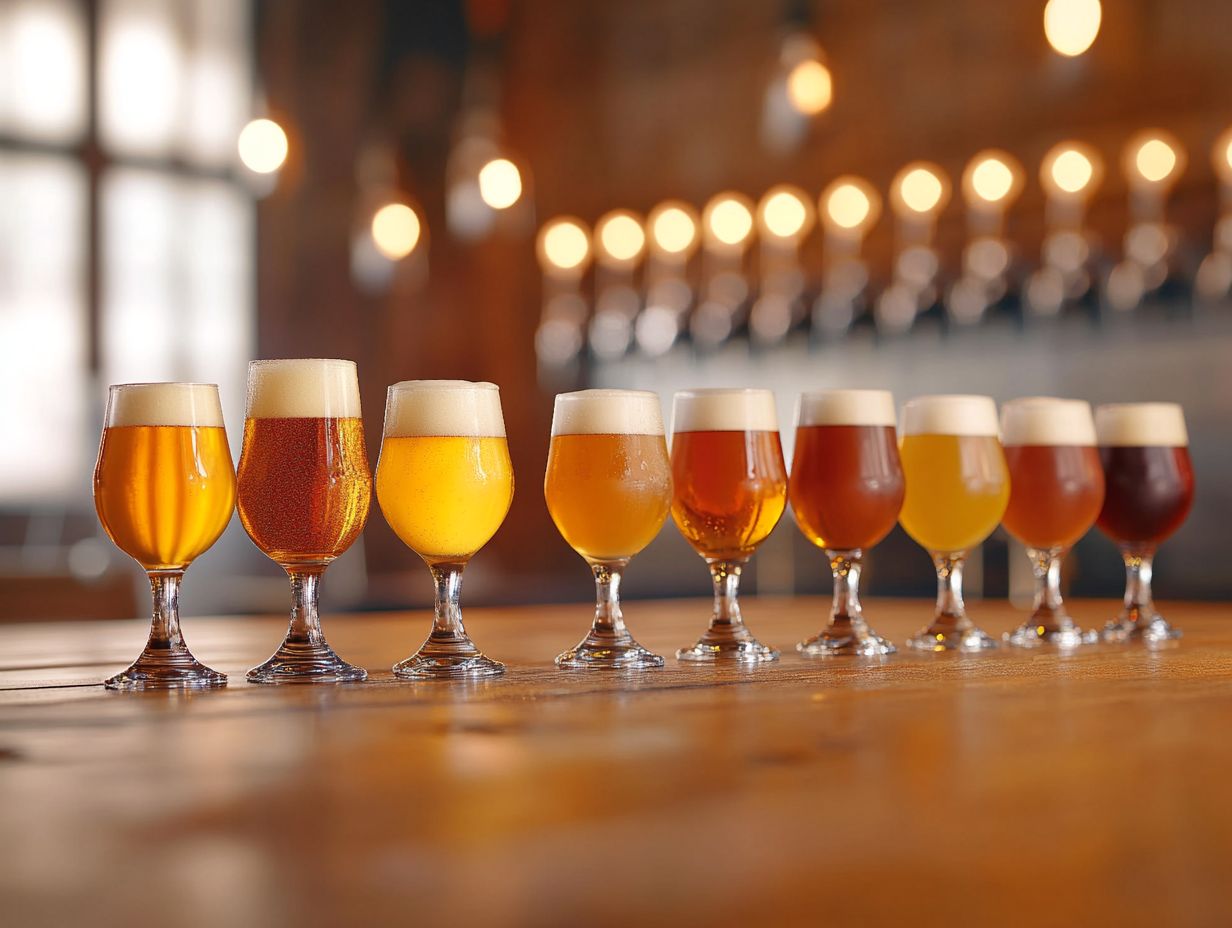
Japanese Rice Lager stands out with its clean and crisp taste, thanks to rice being a key ingredient in the brewing process. This lager style has a light body and refreshing qualities. It is perfect for those who enjoy subtle flavors and a smooth drinking experience. This lager shows how traditional brewing meets modern ingredients.
The brewing process involves fermenting a blend of malted barley and rice, which not only contributes to its signature flavor but also reflects a rich cultural heritage steeped in Japanese brewing traditions. This lager pairs beautifully with sushi and other dishes, enhancing your dining experience! Whether enjoyed on its own or with food, the Japanese Rice Lager offers a clean and enjoyable drinking experience.
Brands like Asahi, Sapporo, and Kirin have gained acclaim for their exceptional takes on this refreshing beverage. Each offers unique flavor profiles that highlight the artistry behind their brewing methods. The global popularity of Japanese Rice Lager is on the rise, resonating with those who cherish its delicate balance and smooth finish. This beer style is winning fans around the globe with its unique taste and refreshing qualities!
Choosing the Right Lager Style
Choosing the right lager style can be a delightful journey, one that invites you to explore the diverse flavors and aromas each variety has to offer. Imagine the refreshing crispness of a Pilsner contrasting with the rich maltiness of a Dunkel.
By understanding your own taste preferences and considering the dishes you plan to enjoy, you can navigate this selection process with ease. This approach helps you find the perfect beer that elevates your dining experience or enhances your social gathering.
What Flavors and Aromas Should You Look for in a Lager?
When selecting a lager, consider the diverse array of flavors and aromas that can elevate your drinking experience. Think about the hoppy notes found in IPAs, the malty sweetness of Dunkels, or the refreshing crispness of classic lagers. Each lager style offers its own distinct profile, allowing you to appreciate the complexities that arise from various brewing methods and ingredients.
Take, for example, a Pilsner. It may greet you with subtle floral and herbal hop aromas, providing a refreshing lift. In contrast, M rzen can envelop your palate with bread-like flavors and caramel undertones, crafting a rich, smooth experience. Meanwhile, a K lsch presents a delicate balance, where slight fruity esters mingle effortlessly with a clean, dry finish.
As you sample different lagers, pay close attention to their aroma first. Raise your glass and take a deep breath to uncover these intricate notes. This technique boosts your enjoyment and helps you discover the unique variations that contribute to the allure of each style.
What Foods Pair Well with Different Lager Styles?
Pairing food with the right lager can truly elevate your dining experience, as different lager styles beautifully complement a variety of dishes, enriching the flavors of both the beer and the meal. For instance, the crisp and clean character of a Pilsner pairs exquisitely with light seafood. Meanwhile, a malty Vienna Lager is a fantastic match for rich meats or savory cheeses.
This delightful interplay highlights the best qualities of each component and creates a welcoming vibe for you and your guests to explore new culinary horizons. A robust M rzen enhances the flavors of roasted vegetables or hearty stews, while a hoppy American Lager is perfectly suited for spicy dishes like tacos or buffalo wings, where its bitterness balances out the heat.
You ll love serving a refreshing Helles with a light salad topped with citrus dressing! The beer s mild flavor complements the freshness without overwhelming it. These thoughtful pairings allow you to appreciate the nuances of both the food and the lager, transforming a simple meal into an unforgettable experience.
In conclusion, exploring the flavors and aromas of different lagers and pairing them with the right foods can elevate both your drinking and dining experiences. Enjoy the journey of discovering new tastes while sharing memorable moments with friends and family.
How to Properly Serve and Store Lager?
Properly serving and storing lager is crucial for preserving its fresh flavors and unique characteristics, greatly enhancing your overall drinking experience. Considerations like the ideal serving temperature, appropriate glassware, and optimal storage conditions are all essential elements that ensure your lager maintains its intended taste profile and quality from the very first sip to the final drop.
Properly serving and storing lager is crucial for preserving its fresh flavors and unique characteristics, greatly enhancing your overall drinking experience. Considerations like the ideal serving temperature, appropriate glassware, and optimal storage conditions are all essential elements that ensure your lager maintains its intended taste profile and quality from the very first sip to the final drop.
What Temperature Should Lager Be Served At?
The ideal serving temperature for lager can vary based on the style, but generally, you ll find that most lagers are best enjoyed chilled, typically between 38 F to 45 F (3 C to 7 C). Serving your lager at the right temperature allows its flavors and aromas to shine through, enhancing your overall drinking experience and ensuring that crispness and refreshing qualities are fully appreciated.
Understanding this temperature nuance is essential, as each lager style boasts distinct flavor profiles that reach their peak within specific ranges. For instance, a light pale lager is best savored around 38 F (3 C), where its clean and refreshing notes truly take center stage. On the other hand, a darker Munich lager benefits from slightly warmer temperatures of about 45 F (7 C), allowing the richer malt undertones to emerge, revealing delightful layers of caramel and toasty flavors.
The ideal serving temperature for lager can vary based on the style, but generally, you ll find that most lagers are best enjoyed chilled, typically between 38 F to 45 F (3 C to 7 C). Serving your lager at the right temperature allows its flavors and aromas to shine through, enhancing your overall drinking experience and ensuring that crispness and refreshing qualities are fully appreciated.
Understanding this temperature nuance is essential, as each lager style boasts distinct flavor profiles that reach their peak within specific ranges. For instance, a light pale lager is best savored around 38 F (3 C), where its clean and refreshing notes truly take center stage. On the other hand, a darker Munich lager benefits from slightly warmer temperatures of about 45 F (7 C), allowing the richer malt undertones to emerge, revealing delightful layers of caramel and toasty flavors.
By paying attention to these temperature suggestions, you can elevate your enjoyment and truly experience the craftsmanship that goes into each lager style and other types of beer.
How Long Can You Store Lager?
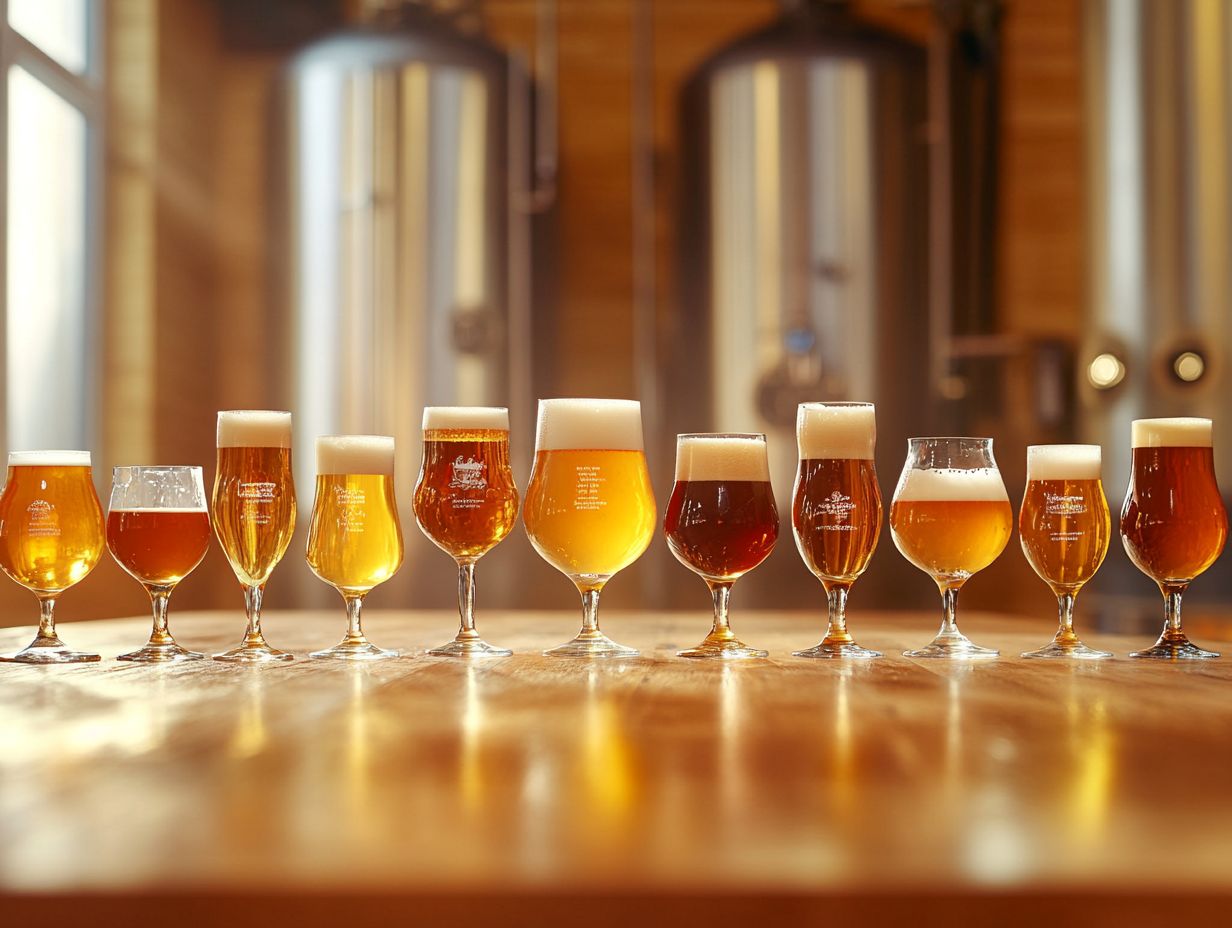
The shelf life of lager can vary greatly depending on its style and how you store it, but in general, you ll want to enjoy most lagers fresh to truly appreciate their intended flavors and aromas. While many lagers can last several months when properly stored, it s wise to check specific guidelines for each style to ensure you re savoring them at their best, much like other styles of beer.
For example, lighter lagers like Pilsners or Helles are celebrated for their crisp, clean taste, which can fade significantly with time. Conversely, darker lagers such as Dunkels and Schwarzbiers may develop more intricate flavors, highlighting the complexities of dark beer, yet they too benefit from thoughtful storage.
To preserve their delightful qualities, keep your lagers upright in a cool, dark place, ideally within a temperature range of 45 F to 55 F. Regularly inspecting your lagers for any off-putting aromas or flavors can help you catch aging issues early; if a beer tastes stale or has an odd smell, it may have seen better days. Keeping an eye on the bottling or expiration dates is crucial for ensuring you enjoy your lagers at their peak, much like you would with other drink options such as ales and stouts.
Frequently Asked Questions About Beers
Exploring Different Types of Lager Styles
What are the different types of lager styles?
The main lager styles are pilsner, helles, dunkel, bock, and Vienna lager. Each style has unique characteristics and a distinct brewing process.
What is a pilsner lager?
A pilsner lager is a light, crisp, and highly carbonated style that originated in the Czech Republic. It is known for its golden color and distinct hoppy flavor, similar to some pale ales and IPAs.
What makes helles lager different from other lager styles?
Helles lager is a pale style that emphasizes malt flavors. It is lighter and less bitter than other lagers, with a slightly sweet finish, making it a popular choice among classic lagers.
What is the difference between dunkel and bock lagers?
Dunkel lagers are dark in color and have a toasted, nutty flavor. In contrast, bock lagers are stronger and have a higher alcohol content. Both styles originated in Germany and share characteristics with other dark beer types such as porter and stout.
What is the history behind Vienna lagers?
Vienna lagers were first brewed in the 19th century in Austria, using a combination of pale and dark malts. They have a copper color and a balanced flavor profile, showcasing the complexities and richness often found in German brews.
What are some food pairings for different lager styles?
Pilsners pair well with light dishes like salads and seafood. Dunkel and bock lagers go well with hearty, meaty dishes. Helles lagers are great with spicy foods, while Vienna lagers complement roasted or grilled meats.
Don’t miss out! Explore these pairings at your local bars for an unforgettable experience.

